Abstract
This review presents our band-selective frequency technology of Electromagnetic Interference (EMI) noise spread spectrum in the DC–DC switching converter for communication devices. The DC–DC switching converter generates electromagnetic interference (EMI) noise. To comply with EMI regulations and reduce the need for bulky filters and shielding, noise spread spectrum technology is commonly employed. However, conventional methods may allow noise to encroach upon the signal band. To address this issue, selective notch frequency technology has been developed. This technology creates notch characteristic spectrum bands, ensuring a low noise level within the received frequency range. It detects the received frequency and generates a notch band there using a switching pulse control technology. This technology employs pulse coding techniques, including pulse width coding, pulse phase coding, and a combination of pulse width and phase coding. Then, we demonstrate a technique that tunes the notch band frequency to the received signal one automatically. We review their underlying principles, theoretical analyses, and experimental results, which validate the effectiveness of the selective notch frequency technology. Also, possible applications of this technology to sensor systems are discussed.
1. Introduction
Nowadays, switching power supply circuits are widely used in many electronic devices, thanks to their advantages of high efficiency, continuously variable output voltage, small size, and light weight [,,,,]. Also, the communication circuit has been enhanced for improved performance and high-density packaging. However, since the switching power supply circuit is driven by a high-frequency clock, it generates some amounts of switching noises called EMI noises, and their reduction is very important [,,,,,,,,,,,,,,,,,,,,,,,,,,,,,,,,,,,,,,,].
In this review paper, first we explain the fundamental DC–DC switching converters employing the Pulse Width Modulation (PWM) control. Then, we show their EMI problems: they cause EMI noises at the clock and harmonics frequencies, and for their reduction, the clock modulation is often utilized by shaking its phase or frequency. In typical scenarios, this technology redistributes noise power across different frequencies, causing an increase in the baseline level, which sometimes causes a problem that the noise is also redistributed in the signal band, such as the AM and FM bands of the radio.
Next, we review our band-selective EMI spread spectrum technique, which realizes both a reduction in the spectrum line noise and the generation of the low noise spectrum band like the notch filter at the receive frequency band of communication devices. Furthermore, its possible applications to sensor systems are discussed.
This paper is organized as follows: In Section 2, the configuration and operation of fundamental DC–DC converters are reviewed. In Section 3, the problems of EMI in switching converters are introduced. In Section 4, conventional methods of EMI reduction with suppressing diffusion are explained, including frequency modulation with an analog spread spectrum clock generator and digital frequency modulation with a linear feedback shift register (LFSR), with the bit-inverse and bit-exchange. In Section 5, select notch band methods with pulse coding control are reviewed, including pulse width coding, pulse phase coding, pulse width, and phase coding. Then, in Section 6, the automatic notch generation method is presented, and in Section 7, its implementation and experimental results are shown. Section 8 discusses possible applications of the reviewed technology in sensor systems. Finally, Section 9 provides the conclusion.
Remark: the selective notch frequency characteristics demonstrated here were tested using prototype circuits built with discrete components rather than integrated circuits (ICs), and the operation and effectiveness were verified. It is important to note that this study is based on well-established switching control methods commonly used in DC–DC converters, which have already been implemented through IC integration. The additional circuitry required to achieve the research outcomes consists entirely of enhancements to the internal feedback control circuits within existing switching power supply ICs. Consequently, while IC integration leads to a slight increase in internal circuitry, it does not result in an increase in IC pin count, making it feasible to realize selective notch frequency characteristics through IC implementation. Then, electrical issues such as ESD, EMS, and input–output voltage levels are comparable to those of conventional DC–DC converters. Additionally, any increase in price or size is anticipated to be negligible.
2. Fundamental DC–DC Switching Converters [,,,,,,,]
There are three fundamental DC–DC switching converters: buck, boost, and buck–boost types. They are composed of power and control stages, and their configurations are almost the same among the three types. The power stage has a switch, an inductor, a diode, and an output capacitor. However, its construction differs among them; the differences are distinguished by their positions. The control stage of each converter is quite similar, consisting of a comparator, a D-type Flip-Flop (DFF), and a reference voltage. Their voltage conversion ratio (Vo/Vi) and polarity of Vo vary, where Vi represents the input voltage, and Vo represents the output voltage: 0 < Vo < Vi for the buck converter, 0 < Vi < Vo for the boost converter, and 0 < −Vo ≷ Vi for the buck–boost converter.
2.1. Buck Converter with PWM Control
Figure 1 shows the configuration and operation of the buck converter. The power stage is composed of a switch (SW), an inductor (L), a diode (Di), and an output capacitor (Co). The control stage is composed of an amplifier (AMP), a comparator (CMP), a D-type Flip-Flop (DFF), and a sawtooth generator (Figure 1a). The red/blue broken line represents the current flow when the PWM pulse is high/low, respectively (Figure 1b,c).


Figure 1.
Configuration and operation of the buck converter.
In the power stage, SW is regulated by the PWM signal. In case the PWM signal is high, SW turns ON, and the input current from the power supply flows through SW to L (as shown by the red broken line in Figure 1b). During this period, the input current increases, flowing into Co and RL, resulting in an increase in Vo (Figure 2) and raising the magnetic energy in L. Conversely, when the PWM level is low, SW turns OFF, and the energy stored in L causes the current to flow through Di (as indicated by the blue dotted line in Figure 1c). Then, Vo decreases and the duty ratio (D) of the PWM signal increases.
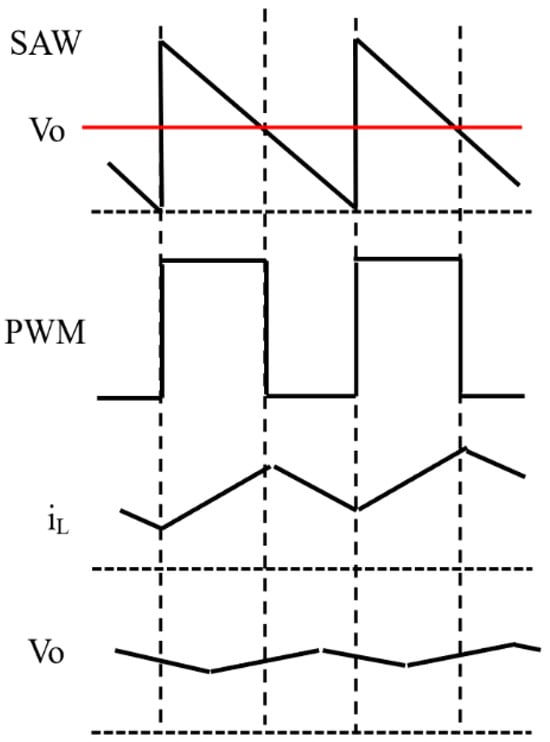
Figure 2.
Waveforms of the buck converter.
In the control stage, the AMP amplifies the voltage error of Vo and the reference voltage (Vref). This amplified error voltage is then compared with the sawtooth signal (SAW), and the PWM signal is generated. The DFF receives these data synchronously with the internal clock (CK) to provide the SAW pulse so that the SAW signal is generated by the sawtooth generator. Vo varies based on D, and Vo is related to D as shown by the following equation:
Vo = D · Vi
Vo is less than Vi due to 0 < D < 1.
2.2. Boost Converter
Figure 3a shows the configuration of the boost converter, where the control stage is the same as the one in Figure 1. When SW is ON, the input current flows through L, and it does not flow to Co or RL, and then L charges the magnetic energy (Figure 3b). When SW is OFF, the current flows from L to Co and RL through Di (Figure 3c). As a result, the current into Co is intermittently interrupted, leading to some output voltage ripple. Vo is expressed by
Vo = 1/(1 − D)·Vi
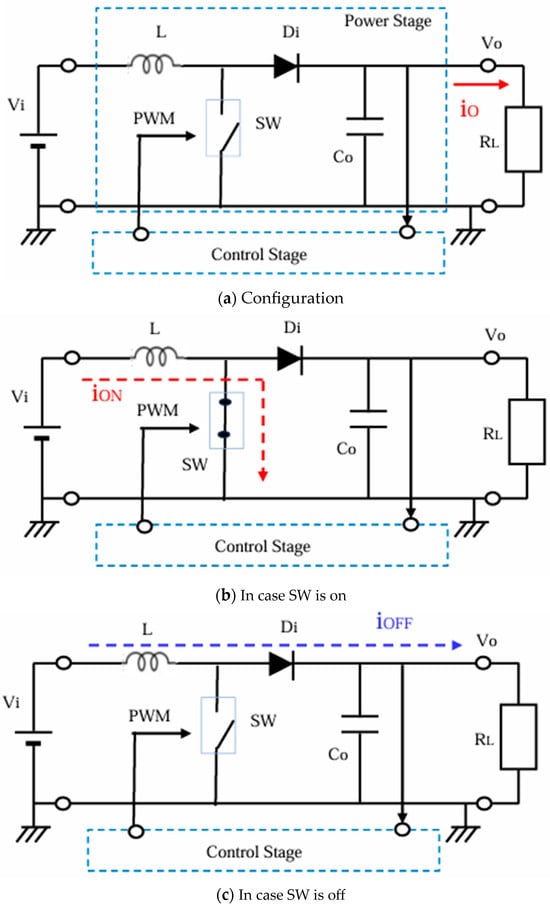
Figure 3.
Configuration and operation of the boost converter.
Notice 1 < 1/(1 − D), and Vo > Vi.
2.3. Buck–Boost Converter
The buck–boost converter produces a negative voltage output. Figure 4a illustrates its configuration. It operates as follows: When SW is ON, the input current flows through SW and L (Figure 4b). When SW is OFF, the inductor current flows into Co in the opposite direction, as indicated by the blue dotted line in Figure 4c. As a result, the polarity of Vo becomes negative. Vo can be expressed by Equation (3), and the absolute value of Vo varies widely over or less than Vi.
Vo = −D/(1 − D)·Vi

Figure 4.
Configuration and operation of the buck–boost converter.
Remark:
- (i)
- There is still room for improvement in current DC–DC converter topologies, depending on their specific applications. For example, see [];
- (ii)
- Another type of switching-mode converter is the switched-capacitor converter, which comprises only switches and capacitors, without the need for inductors or transformers []. Its features are light weight, small size, high power density, and low EMI emissions. However, it has certain limitations, such as its capacity to handle only limited output current, its output voltage being step-wise rather than continuous, and its relatively low efficiency. This paper does not discuss this type of converter because of its low EMI emissions.
3. EMI Problems in DC–DC Converters
In the above-mentioned three basic types of switching DC–DC converters, input voltage is stepped down or stepped up by rapidly switching the voltage and current applied to the main inductor. In this process, high-frequency currents are switched through the input power source (Vi) and its supply lines, and high-speed voltage and current switching occurs across the main switch, inductor, diode, and their wiring paths. As a result, large high-frequency currents flow through the input voltage lines and switching lines, emitting unwanted EMI noise as if they were antennas.
There are several EMI test standards, including the IEC 61,000 series, CISPR 16, EN standards, FCC standards, and VCCI. Electronic appliances must meet these standards, depending on regions and applications [,,]. Figure 5 shows one example of the CISPR regulations.

Figure 5.
EMI regulation in Japan (CISPR22).
Noise spread spectrum techniques in DC–DC converters can help meet these standards and alleviate the burden of bulky filters and shields. They are effective in reducing EMI noise caused by conduction interference, radiation interference, common-mode noise, and differential-mode noise. The EMI noise exhibits a significant line spectrum and includes substantial noise spectra extending into high-frequency bands (Figure 6a).
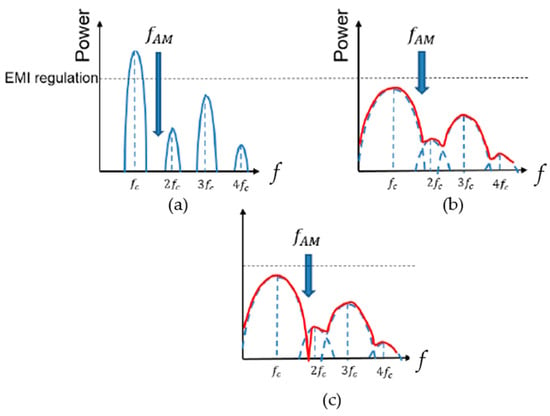
Figure 6.
EMI from DC–DC converter. (a) Original spectrum without clock modulation. (b) With conventional noise spread spectrum method. (c) With band selective noise spread spectrum method.
To address this, conventional noise-spreading techniques modulate the frequency of the clock pulse driving the power switch (Figure 6b). By dispersing the prominent line spectrum periodically, the peak levels of the spectrum are reduced. While this method effectively lowers the peak levels of specific spectra, it also spreads noise across the entire frequency range. Although this approach is effective for meeting EMI test standards, it can be detrimental to devices designed to receive weak radio signals. The noise emitted from power circuits primarily consists of harmonics and noise synchronized with the internal clock. The noise with the highest energy level is generated by the switching operation of the power switch MOS and its driving pulses. Electromagnetic noise caused by these switching operations can manifest as radiated interference noise emitted into the air from wiring or cables, or as conducted interference noise that disrupts other circuits within the system or external devices connected via the power supply line. Essentially, these interference noises can interact with other devices as differential mode noise.
The root cause of these interference noises lies entirely in the switching frequency of the clock pulses that control and drive the power semiconductors, as well as their harmonics. Therefore, we monitored and checked the EMI interference noise generated by these clock pulses. Additionally, we explored new coding techniques for these clock pulses and investigated a clock pulse control method for DC–DC switching power supplies that could produce notch characteristics with significantly reduced noise within specific frequency bands of the resulting EMI noise spectrum (Figure 6c).
4. Conventional Methods of EMI Reduction with Suppressing Diffusion [,,,,,,,,,,,,,,,,,,,,,,,,,,]
This section reviews some spread spectrum technologies for EMI reduction with diffusion suppression of the power supply and switching noises. This technology has a long history [,,,,,,,,,,,,,,,,,,,,,,,,,,]. Basic spread spectrum technologies for clock noise involve modification of the clock with frequency, phase, and pulse width. The following will illustrate the one with the coding of the clock using both analog and digital methods.
4.1. Frequency Modulation with Analog Spread Spectrum Clock Generator
(A) Configuration and operation
It is recognized that the clock frequency or phase modulation in switching converters spreads the power spectrum of the EMI noise from the PWM signal and decreases its peak level at the clock and harmonics frequencies. Figure 7 illustrates the clock frequency modulator, which replaces the control block in Figure 1 to implement the buck converter with a noise spread spectrum capability. Figure 8 shows its associated signals. There, the voltage-controlled oscillator (VCO) is incorporated for the modulation of the frequency or phase of the SAW signal.
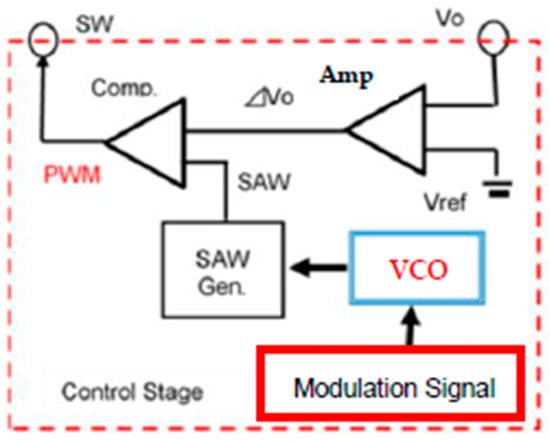
Figure 7.
Frequency modulator in control stage.

Figure 8.
Signals for frequency modulation.
Figure 9a illustrates the spectrum of the PWM signal without clock modulation, whereas Figure 9b illustrates the one with modulation by two frequencies. The clock noise power spectrum is spread around the clock and harmonics frequencies. Several line spectra, indicated by the solid arrows, are discretely spread (marked by the dashed arrows); there, the peak power levels are reduced.

Figure 9.
Spread spectrum of PWM pulse [] @JTSS.
(B) Simulation results
Figure 10 illustrates the spectrum of the PWM pulse without clock modulation. At the clock frequency of 0.5 MHz, a line spectrum reaching 3.5 V is observed, along with many harmonics. For the clock noise reduction, its modulation is utilized by shaking its phase or frequency (Figure 7). Figure 11 displays the spectrum with modulation. Since the power at the clock and harmonics frequencies spread to other bands, their peak levels become lower, though the bottom level becomes higher.
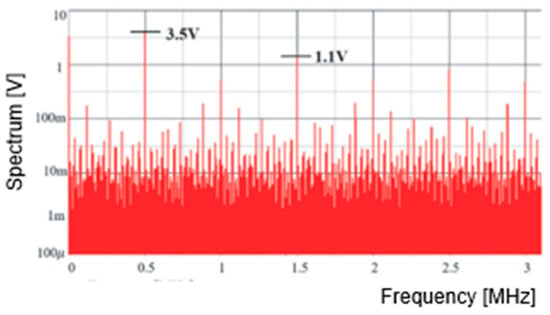
Figure 10.
PWM spectrum without clock modulation.
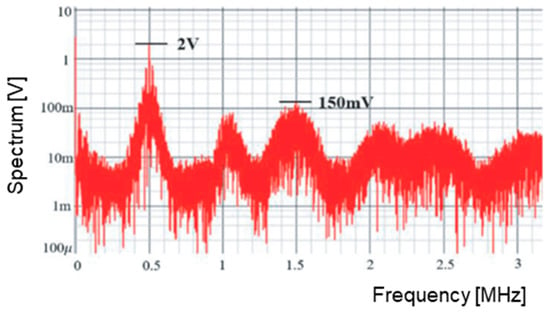
Figure 11.
PWM spectrum with modulation.
4.2. Basic Digital Frequency Modulation with LFSR
(A) Configuration and generated pseudo analog signal
Pseudo-analog noise generation using a Phase Locked Loop (PLL) clock generator for modulation is reviewed.
Figure 12 illustrates the 3-bit linear feedback shift registers (LFSRs) or M-sequence circuits. Based on G3_1(x) in Equation (4), the outputs of the 3rd and 2nd bits are connected to the inputs of the Exclusive NOR (EX-NOR) gate, and its output is provided to the first DFF. The n-bit LFSR generates K (=2n −1) levels, where n is the order of the primitive polynomial. For n = 3, K is 7, and there are two primitive polynomials, G3_1(x) in Equation (4) and G3_2(x) in Equation (5).

Figure 12.
Three-bit LFSRs for two primitive polynomials [] @JTSS.
Figure 13 illustrates the analog output levels obtained from (Q3, Q2, and Q1) by the LFSR in Figure 12. There are periodic patterns with seven levels: 0-1-3-6-5-2-4 or 0-1-2-5-3-6-4. These are transformed into a smooth signal as pseudo-analog noise. This pseudo analog noise is introduced into the PLL, and then its output is frequency-modulated (Figure 14). Also, the PLL does not lock to the input noise due to its sluggish step response characteristics (Figure 15).
G3_1(x) = x3 + x2 + 1
G3_2(x) = x3 + x + 1
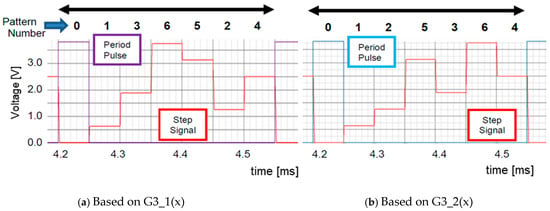
Figure 13.
Waveforms of output levels with LFSRs [] @JTSS.

Figure 14.
Configuration of the clock generator with analog modulation [] @JTSS.

Figure 15.
Step response of the PLL [] @JTSS. Green: Step input. Red: Output.
(B) Simulation of clock modulation with pseudo analog noise
The clock generator with modulation by the pseudo analog noise is illustrated in Figure 14. The generated pulse train by the LFSR in Figure 12 is converted to the analog signal by the DAC and smoothed by the LPF, and it is supplied to the PLL. Figure 15 shows the simulated characteristics of the damped vibrated signal when the input signal is changed with some steps.
Figure 16 displays the pseudo analog noise (Vn: periodic), the VCO input signal (Vcont: non-periodic), and the output voltage ripple (⊿Vo: non-periodic) when an LFSR based on G3_1(x) is used. The clock frequency is 400 kHz, while the shift clock of the LFSR in Figure 12 is 10 kHz. Then, the periodic frequency of Vn is 1.43 kHz, and ⊿Vo is about 10 mVpp. Table 1 shows the simulation parameters, and SIMPLIS is used as simulator.
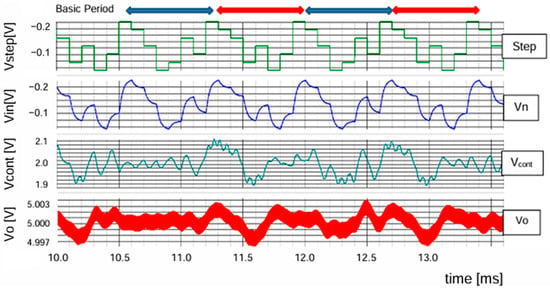
Figure 16.
Signals associated with PLL circuit [] @JTSS.

Table 1.
Simulation parameters.
Figure 17 displays the simulated spectra of the PWM signal (red) and the conducted noise (green). Figure 17a displays the spectra without the pseudo-analog noise (Np), whereas Figure 17b includes the ones with Np. The peak level at the clock frequency is reduced from 3.0 V to 0.55 V, and that at the 3rd harmonic is reduced from 1.0 V to 0.1 V, while that of the conductive noise is reduced from 350 mV to 70 mV.
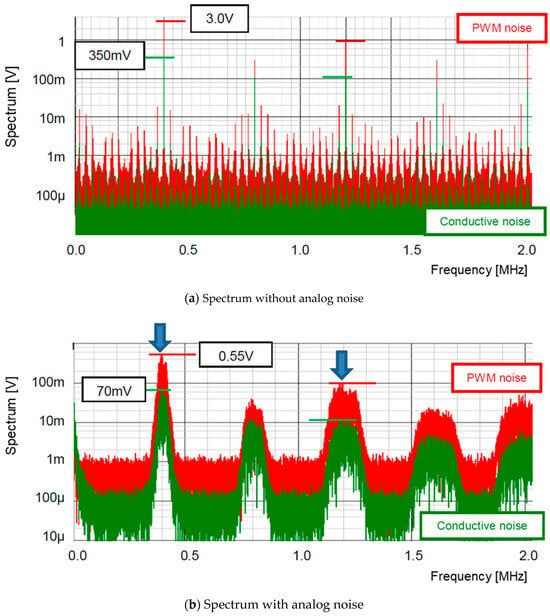
Figure 17.
Spectrum of PWM and conductive noises [] @JTSS.
4.3. Analog Noise Generators Using Bit Operation
(A) Expansion of analog pattern length using bit-inverse
We explain an analog noise generator using bit-exchange for an LFSR. The longer the period of the analog noise, the lower the peak level at the specific frequency, resulting in a broader sideband spectrum. The 3-bit system produces eight analog levels, and the number of permutations of the pattern levels is 7P7 = 5040. Thus, a larger number of bits increases the number of permutations. For instance, inversing some of the bits from the LFSR output produces other pattern levels.
Additional patterns from the combination of these pattern levels are included. Equations (6)–(13) illustrate the results of the bit-inversed level streams of Equations (4) and (5). Usage of these streams extends the analog noise period to 8 times that of the original. The pattern length using the bit-inverse results in T1 = 8·2·7 = 16·To, where To is the original pattern length of 7.
[Based on G3_1(x)] : [Based on G3_2(x)]
(1) Q1 Q2 Q3 : 0 - 1 - 3 - 6 - 5 - 2 - 4 - : 0 - 1 - 2 - 5 - 3 - 6 - 4 -
(B) Simulation results of pattern generator with bit-inverse
Figure 18 illustrates the simulation circuit of the LFSR (M-sequence circuit) with bit-inverse based on G3_1(x). The bit-inverse uses three EX-NOR gates, in conjunction with a 3-bit binary counter, that is triggered once within a period of the LFSR counter. In Figure 18, the binary counter increments when all bits of the LFSR counter are zero, and CK is triggered when all the outputs of the binary counter are zero. The periodic length of the 3-bit DAC input (B3, B2, B1) extends to 8 times To (Figure 18 and Figure 19).
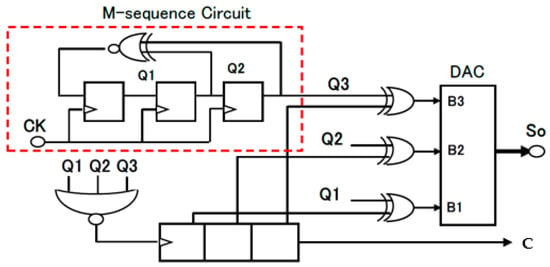
Figure 18.
Pattern generator using bit-inverse [] @JTSS.
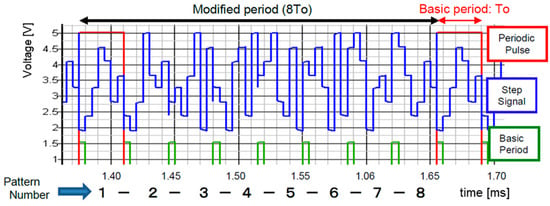
Figure 19.
Expanded pattern length using bit-inverse [] @JTSS.
Figure 20 displays the output voltage ripple (⊿Vo) of the converter using pseudo analog noise, while Figure 21 illustrates the spectrum of the PWM signal and the conductive noise using bit-inverse. The ripple voltage is 8.5 mVpp. The peak level at the clock frequency is reduced from 550 mV to 500 mV, and the level of the conductive noise is from 70 mV to 60 mV, compared to Figure 17b.
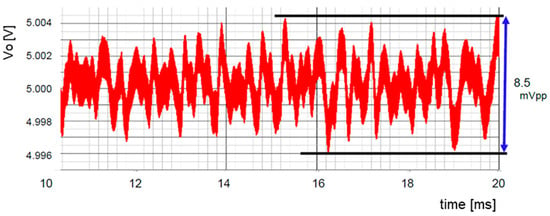
Figure 20.
Output ripple of the buck converter using bit-inverse [] @JTSS.
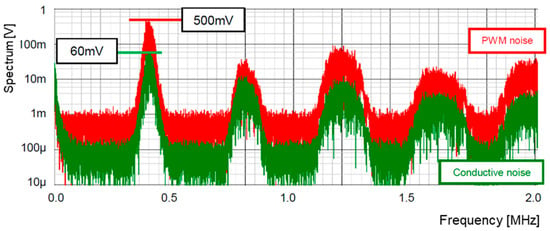
Figure 21.
Spectrum of the buck converter output using bit-inverse [] @JTSS.
4.4. Pattern Generator Using Bit-Inverse and Bit-Exchange and Simulation Results
(A) Expansion of analog pattern length using bit-inverse and bit-exchange
The bit-exchange technique for expansion of the analog noise period is introduced. There are no identical bit streams in terms of Equations (6)–(13). The new pattern length becomes 6 times the one with only bit-inverse (T2 = 6·T1 = 96·To).
[Based on G3_1(x)]:[Based on G3_2(x)]
(1) Q1Q2Q3 : 0 - 1 - 3 - 6 - 5 - 2 - 4 - : 0 - 1 - 2 - 5 - 3 - 6 - 4 - [basic]
(2) Q1Q3Q2 : 0 - 1 - 5 - 6 - 3 - 4 - 2 - : 0 - 1 - 3 - 5 - 2 - 4 - 6 -
(3) Q2Q1Q3 : 0 - 2 - 3 - 5 - 6 - 1 - 4 - : 0 - 6 - 2 - 3 - 5 - 1 - 4 -
(4) Q2Q3Q1 : 0 - 4 - 5 - 3 - 6 - 1 - 2 - : 0 - 4 - 3 - 2 - 5 - 1 - 6 -
(5) Q3Q1Q2 : 0 - 2 - 6 - 5 - 3 - 4 - 1 - : 0 - 6 - 5 - 3 - 2 - 4 - 1 -
(6) Q3Q2Q1 : 0 - 4 - 6 - 3 - 5 - 2 - 1 - : 0 - 4 - 5 - 2 - 3 - 6 - 1 -
(B) Simulation results of pattern generator using bit-inverse and bit-exchange
Figure 22 illustrates the configuration of the LFSR using bit-inverse and bit-exchange. The bit-inverse circuit is shown in Figure 18, and the bit-exchange circuit is composed of a multiplexer array. At the 3-bit DAC output, the number of analog steps is 48 times that of the original pattern. Figure 23 illustrates its simulated spectra. The peak level of the PWM pulse noise is reduced from 500 mV to 400 mV (−17.5 dB), while the conductive noise remains 60 mV, compared to Figure 21.
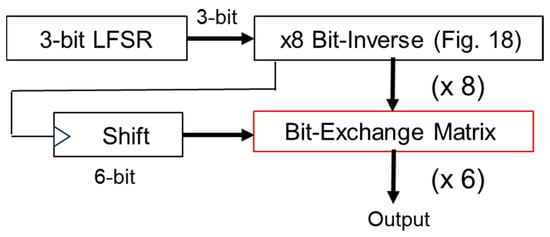
Figure 22.
Pattern generator using bit-inverse and bit-exchange [] @JTSS (Figure 18).

Figure 23.
Spectrum with bit-inverse and bit-exchange [] @JTSS.
4.5. Expansion of Number of Pseudo Analog Noise Generator Bits
(A) Expansion of number of bits
We found that it is not the number of bits for the LFSR that reduces EMI noise, but rather the ratio of the variation in pattern levels of the LFSR. There are two 4th-order primitive polynomials, and the bit level series are given in Equations (27) and (28), while the number of the pattern variations is To = 24 − 1 = 15.
[4th-order] G4_1(y) = y4 + y3 + 1
G4_2(y)= y4 + y + 1
[Pattern] G4_1:0-1-3-7-14-13-11-6-12-9-2-5-10-4-8-
G4_2:0-1-2-5-10-4-9-3-6-13-11-7-14-12-8-
(B) Simulation results with 4th-order primitive polynomials
Figure 24 illustrates the output step pattern from the 4-bit LFSR and the output of the LPF following the 4-bit DAC with the bit-inversed versions of Equations (19) and (20). The step pattern consists of non-periodic pulses, because the condition of the initial bit patterns in the LFSR varies based on the previous ones. Figure 25 illustrates the spectrum of the PWM pulse. The peak level is 600 mV, which matches the one with 3rd-order primitive polynomials.

Figure 24.
Signals of 4-bit LFSR with bit-inverse [] @JTSS.
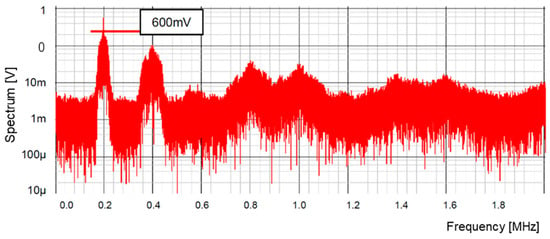
Figure 25.
Spectrum of PWM pulse using 4-bit LFSR with bit-inverse [] @JTSS.
There is little difference in the EMI reduction for the 3-bit and 4-bit LFSRs with the bit-inverse operation. Therefore, only the 3-bit LFSR is sufficient, and we see that fine frequency changes in modulation are not necessary.
5. Notch Band Select with Pulse Coding Control [,,,]
This section reviews our EMI noise spread spectrum techniques with notch band selection using pulse coding methods: pulse width coding (PWC), pulse cycle coding(PCC), and pulse width and phase coding (PWPC). The notches appear at frequencies determined by empirical equations. We demonstrate the relationships of the notch frequencies and the coded pulses in simulation. Also, their analytical formulae are shown.
5.1. Pulse Width Coding (PWC) Control
(A) Basic pulse coding control
In the pulse coding control method, the switch is regulated by the Pulse-Coded Drive (PCD) signal, that is selected from two coded PWM pulses (Figure 26). Pulse 1 and Pulse 2 are generated using various coding methods with parameters for the pulse width, pulse phase, and their composite, and then, one is selected by SEL.
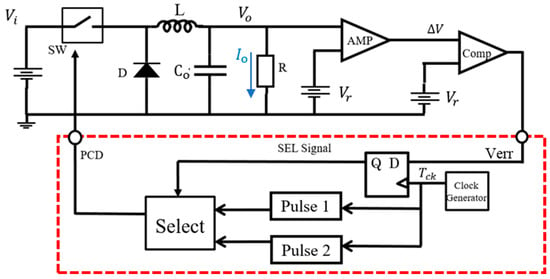
Figure 26.
Switching converter with basic pulse coding control [] @IEEE.
(B) Pulse Width Coding (PWC) control
The PWC method discretely modulates the feedback pulse width. Figure 27 illustrates the PWC control circuit, and SEL is generated from the error voltage (Verr). Figure 28 illustrates the SEL, , , and PWC pulse ( and ). When SEL is high, the multiplexer selects , and the comparison with SAW generates . When SEL is low, it selects , and the comparison with SAW generates . The output voltage is stably controlled by satisfying the following equation:
DL < Do (=Vo/Vi) < DH
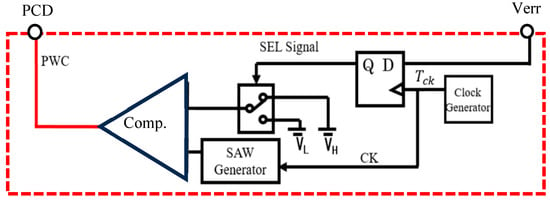
Figure 27.
PWC control circuit.
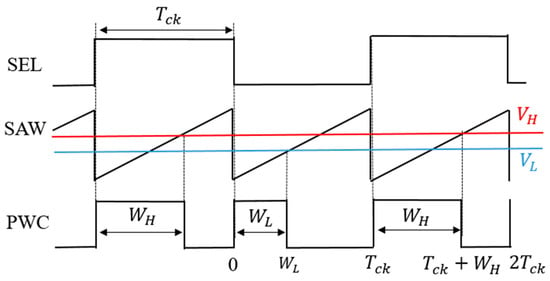
Figure 28.
Signal waveforms for PWC control.
In the PWC control, the analog output voltage error is converted to a digital signal, and it modulates pulses. The converter output voltage is stabilized by appropriately switching these pulses. As a result, the noise spectrum is spread, and its notch is generated. Simulation shows that the notch frequency () is given as follows:
Fn = N/(WH − WL)
Hereafter, N is a positive integer throughout this paper. We observe that is determined by the difference of WH and WL, and it is independent of the clock frequency. By adjusting WH and WL, can be set arbitrarily.
(C) Simulation Results of PWC Control
The pulse-coded control regulates the converter output voltage using only two pulses, but without a sawtooth signal. The clock frequency is set to exceed 500 kHz to ensure precise control of the output voltage, and the other parameters are in Table 2.

Table 2.
Parameters of PWC control simulation.
The SAW peak voltage is set to 12 V, is et to 9.6 V, and is set to 1.8 V. Comparisons of and with the SAW under = 2 μs results in of 1.6 μs and of 0.3 μs, respectively. Figure 29 illustrates SEL and PWM signals, while Figure 30 displays the PWC signal spectrum. The up-arrows indicate the clock, its double, and its triple frequencies. A notch is observed at 770 kHz), corresponding to the theoretical frequency from Equation (24). Another notch is generated at 1.54 MHz, which corresponds to 2. However, this notch is not very prominent due to the high-frequency noises from the clock. Comparing the peak level at the clock frequency in Figure 10 with that in Figure 30, it is suppressed from 3.5 V to 1.1 V. Also, notches are produced.
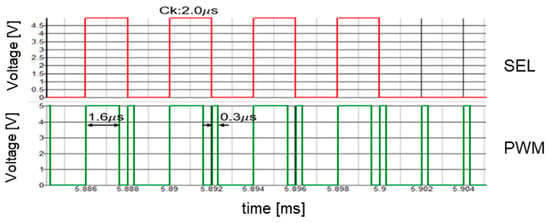
Figure 29.
Signals of PWC control.
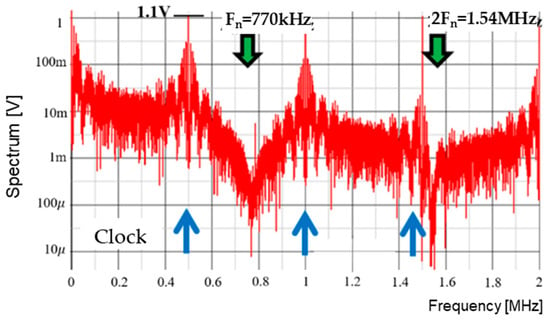
Figure 30.
Spread spectrum of PCD signal with PWC control.
5.2. Pulse Phase Coding (PPC) Control
Pulse phase coding (PPC) control is realized with a delay circuit and a multiplexer (Figure 31). However, it does not alter D, and it is used with the PWC system. Parameters are used for the notch frequency based on the empirical formula (Equation (24)). Let τ represent the delay of pulse coding, with the longer delay represent as and the shorter one represented as (Figure 32). The notch characteristics are also obtained using the PCC method. In case of a pulse train with a clock cycle of , the period T(k) of the k-th pulse is given by the following equation:

Figure 31.
PPC control circuit.
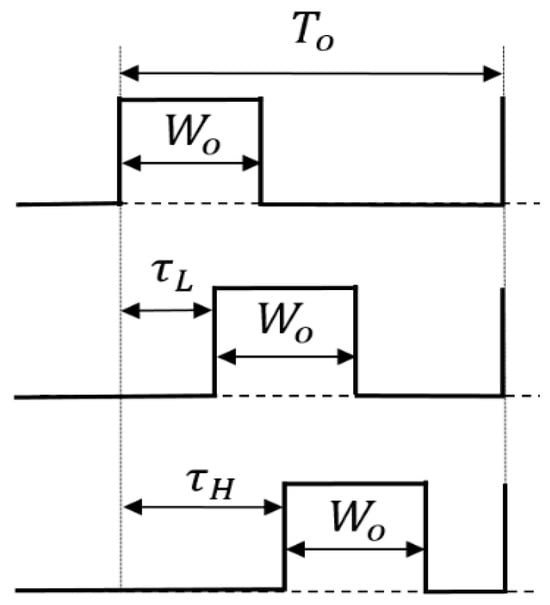
Figure 32.
Signals of PPC control.
We see that in the PPC method, the notch is dependent on the previous pulse. Therefore, notches are unlikely produced because the coding cycle T(k) has 22 patterns. To address this, the following two periodic patterns can be utilized if alternate high/low coding is applied to the phase coding:
TH = T + {τH − τL}, TL = T − {τH − τL}
We obtain Equation (27) from Equations (24) and (26) as follows:
Fnp = N/[2 (τH − τL)]
We see from Equation (27) that the notch characteristics are determined by twice the difference in the pulse phases.
5.3. Pulse Cycle Coding (PCC) Control
(A) PCC control circuit
In Figure 33, the duties of the two coded pulses differ as described by Equation (26). Consequently, the duty cycle changes by altering the pulse period (Figure 34). Figure 35 shows an example of two pulses using the PCC method. There, = 0.4 μs, = 0.5 μs, and = 2.0 μs. Consequently, = 0.8 and = 0.2. The notch frequency in the spectrum of the PCD signal is given by
Fnc = N/(TL − TS)

Figure 33.
PCC control circuit.

Figure 34.
PCD pulse of PCC control.
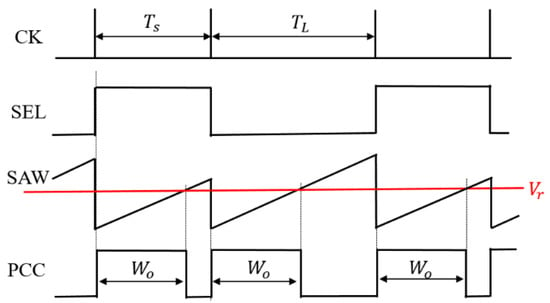
Figure 35.
Main waveforms of PCC control.
Figure 33 shows the generator of these coded pulses. Pulses with different periods are generated from the pulse generation counter based on SEL (Figure 34). Here, and are defined as the pulse periods which are produced based on the SEL high and low states. By utilizing a differential circuit, a periodically modulated clock signal is generated. The generated sawtooth is compared with , and the PCC pulse is produced. Figure 35 shows signal waveforms associated with the pulse coding in the PCC system. The clock cycle varies depending on SEL, and the PCC signal synchronized with that cycle is the output.
(B) Simulation Result with the PCC Control
Figure 36 illustrates the main signals, and the pulse lengths of the PCC signal vary based on SEL. Figure 37 presents the simulated spectrum of the PCD signal with the PCC control. There, the pulse conditions are = 600 ns and = 220 ns, resulting in a notch frequency of = 2.6 MHz, as calculated from Equation (28). However, in Figure 37, notches appear around though they are not clearly visible. There are many line spectra because the spread spectrum technique is not utilized. The frequency position of the notch spectrum can be altered by the coded pulse frequencies or the switching converter parameters. Table 3 shows the simulation parameters.

Figure 36.
Simulated signals of PCC method.
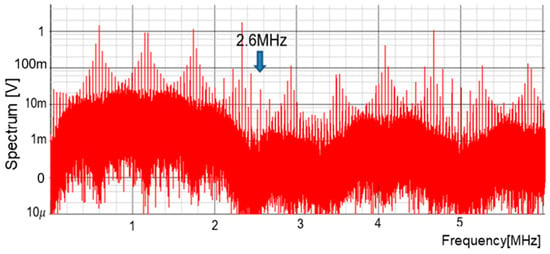
Figure 37.
Spread spectrum of PCD signal with PCC control (without spread spectrum).
5.4. Pulse Width and Phase Coding (PWPC) Control
(A) PWPC Method
The PWPC method is realized by incorporating a PPC circuit followed by the SAW generator for PWC (Figure 38). There, the frequency for a large notch is designed using Equations (27) and (28). Figure 39 illustrates the SEL and PWPC signals. When SEL is high, is selected, and when SEL is low, the shifted is selected. It is observed that the notch produced by the PWPC method is deeper compared to the PWC method.
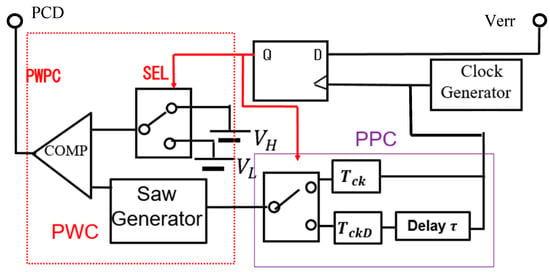
Figure 38.
PWPC control circuit.
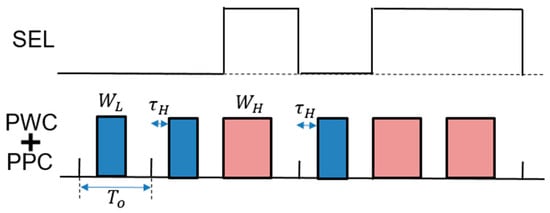
Figure 39.
Signals of PWPC control in Figure 38. Light red: Narrow pulse. Light blue: Wide pulse.
(B) Simulation Results with PWPC Control
In simulation, we set To = 500 ns, WH = 320 ns, WL = 160 ns, τH = 80 ns, and τL = 0 ns to produce a large notch at 6.25 MHz. Figure 40 illustrates the simulated spectrum of the PWPC signal. The noise level at the notch frequency is less than −20 dB relative to the average level.
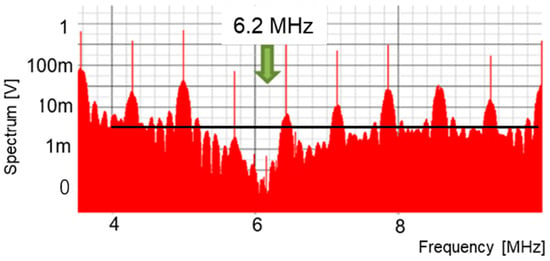
Figure 40.
Spread spectrum of PCD signal with PWPC control.
5.5. Derivation of Notch Frequency Using Fourier Transform
Now, we analyze various pulse coding methods and derive the formulae for their notch characteristics. We break down the analysis into four steps:
- (1)
- Define the signal of the pulse coding method;
- (2)
- Determine its Fourier transform;
- (3)
- Take its absolute value to obtain their spectrum characteristics;
- (4)
- Derive its zero point.
(A) Analysis of PWC Control
First, we analyze the PWC control. One period of the PWC signal is defined as , which has two different pulse widths: and (Figure 41). The zero frequency of the PWC control spectrum is obtained as Equations (29)–(31), using Fourier transform on the pair of coding pulses.

Figure 41.
One-period two-pulse train of PWC signal.
Then
) =
Now we have the following:
We see that the PWC spectrum is expressed by a sinc function, which depends on the difference in pulse widths. The frequency at the zero point is obtained as follows:
Equation (32) shows that the notch characteristics correspond to the zero of the sinc function. Notice that the notch frequency is determined by the difference in pulse widths, and it is independent of the clock frequency.
Next, calculate the spectrum characteristics of the eight rows of PWC pulses in Figure 42. Assume that the entire eight trains of pulses have a period , and the Fourier transform yields Equation (33).

Figure 42.
One-period eight-pulse train of PWC signal. Light red: Narrow pulse. Light blue: Wide pulse.
The calculated result of the notch frequency based on Equation (33) is the same as that of Equation (32).
The notch characteristics depend solely on the difference of pulse widths, regardless of the arrangement and number of pulses. The frequency at the zero point is obtained by the following equation:
Figure 43 illustrates a comparison between the sinc function and the spectrum of the PWC waveform with = 3 μs, = 7 μs, and = 250 kHz. The envelopes of the spectrum in simulation match the theoretical result (Equation (35)).

Figure 43.
Comparison of theory and simulation.
(B) Analysis of PPC and PCC controls
We analyze the pulse position coding (PPC) method. As illustrated in Figure 44, we define the PPC signal in one period as , which consists of two different phase pulse coding signals ( and ). The frequency characteristics of the PPC control are obtained by Fourier transform on the pair of coding pulses (Equation (36)).

Figure 44.
One-period two-pulse trains of PPC signal.
By taking the absolute value, Equation (37) is derived, which shows the frequency at the zero point as Equation (38):
According to Equations (37) and (38), the PPC method relies on two sinc functions, each exhibiting distinct notch characteristics. This method relies on the coding phase and the pulse width. Here, Equation (38) represents the theoretical equation of the PPC method when alternating coding is employed.
Next, we analyze the PCC method. We define the PCC signal in one period as , which consists of two different cycle coding signals: and (Figure 45). The theoretical frequency of the PCC control is obtained as Equation (39) by Fourier transform on the pair of coding pulses.

Figure 45.
One-period two-pulse train of PCC signal.
This equation shows that the notch characteristic depends on both the coding period and the pulse width, as in the PPC method.
(C) Analysis of PWPC method
Next, we analyze the pulse width and phase coding (PWPC) method, which encodes both the pulse width and phase. We define the PWPC signal in one period as , which represents two coding signals (Figure 46). The frequency characteristics of the PWPC control are derived as Equations (41) and (42).

Figure 46.
One-period four-pulse-train of PWPC signal.
In the PWPC, a sinc function with the pulse width and phase is used for representation, and two notch characteristics are generated. Further, if the notch characteristics are set to overlap with ∣, they become as follows:
Figure 47 provides a comparison of the notch characteristics in Equations (43) and (31). The notch around the zero point at 250 kHz in Equation (43) is broader than in Equation (38). The composite coding method increases both the notch width and depth compared to the PWC or PPC method.
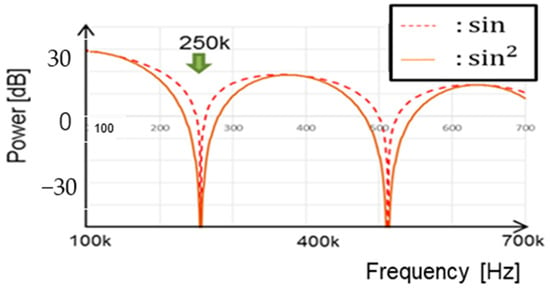
Figure 47.
Comparison of notch characteristics with PWC and PWPC methods.
6. Automatic Notch Generation [,,,]
This section describes the generation method of and for automatic notch generation in PWC control and PWPC control.
6.1. Automatic Notch Generation Using PWC Control
(A) Design of Relationship Among , and
Our design is the generation of the notch frequency so that it lies between and 2, and it matches the received signal frequency (Figure 48). is provided to match the receiving frequency, and the relationship among , , and is given by Equation (44). Here, P is a positive integer. Then, the relationship of (=and is given by Equation (45).
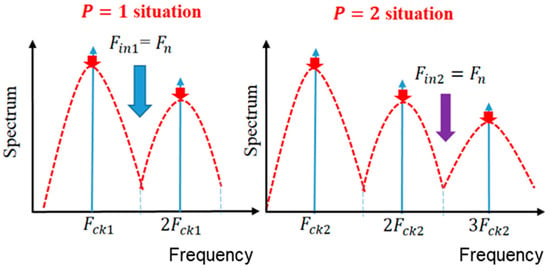
Figure 48.
Positions of [] @IEICE.
We see from Equation (44) that in case of P = 1, is set between and 2, and it is equal to . In the case of P = 2, is produced between and 3, and (Figure 48).
Conversely, the duty ratio D of the PWC signal is represented by Equations (46)–(48). Further, the original clock signal in Figure 49 represents the PWC signal that is not encoded, with a pulse width of . It also corresponds to Equation (46), where is set to 0.5. Pulse-H and pulse-L are generated based on (Figure 49), and this corresponds to Equation (47). Here, represents the difference of and , or of and . is determined by the difference of and . Also, , , and must satisfy the relationship given in Equation (48) to ensure a stable output voltage, . Here, 2 = , and it is the difference of and .
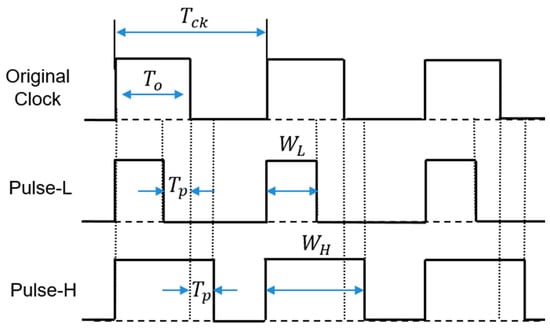
Figure 49.
Timing of pulse-H and pulse-L [] @IEEE.
(B) Automatic Notch Generation from Clock
is generated by as shown in Equation (45). For P = 1, the notch frequency is produced between and 2 from (See Figure 48). is shown in Equation (49), which can be realized with a shifter and an adder. Figure 50a,b show the automatic PWC pulse coding circuit based on Equations (46)–(48) for , where and . Figure 50a shows the whole block diagram, while Figure 50b shows the detailed block diagram of pulse-H and pulse-L generation from , and . Then, in the case of P = N, is produced between N and (N+1) with as shown in Equation (50).

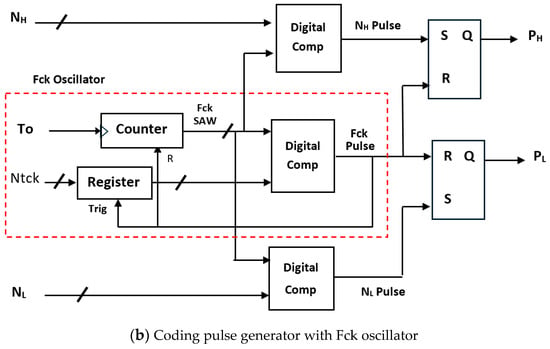
Figure 50.
Pulse coding circuit of automatic PWC method for [] @IEEE.
Figure 51 illustrates the automatic PWC method for P = N. For instance, in the case of N = 2, is set to 1.25 MHz, is 500 kHz, and appears at 1.25 MHz, which falls between 2 and 3 .
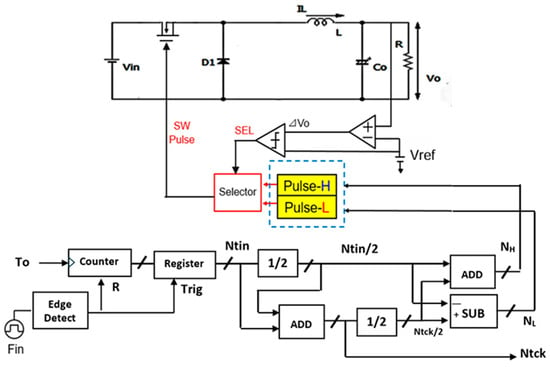
Figure 51.
Pulse coding circuit of automatic PWC method for .
(C) Simulation Results with Automatic Notch Generation
A digital circuit is used for coding pulse notch generation for (Figure 50). Figure 52 displays the waveforms of pulse-H and pulse-L for = 750 kHz. The sawtooth period is automatically set to 2 μs. By comparing and , pulse-L and pulse-H with and are generated automatically. According to Equation (23), is 750 kHz, and the spectrum of the PWM signal is shown in Figure 53. The notch is at 750 kHz, which corresponds to , and there the bottom level is 1 mV. However, there is the line spectrum at (=500 kHz) with an amplitude of 900 mV, and multiple harmonics spectra are present. Thus, frequency modulation is considered for spread spectrum in the coding pulse notch generator.

Figure 52.
Simulated waveforms for .
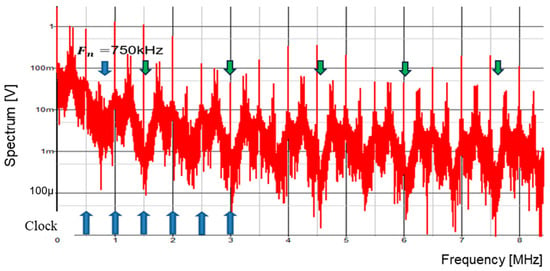
Figure 53.
Simulated spectrum of PWM signal without spread spectrum (P = 1).
The frequency modulation of is used for EMI reduction as described in Section 5.1, and the spectrum of the PWM signal is displayed in Figure 54. The notch is clearly observed at 750 kHz (. The bottom level of the notch frequency is 1 mV, while the spectrum at (=500 kHz) is 20 mV. Notice that another notch appears also at 4 in simulation. In principle, a 3 MHz frequency is equal to 6). Since the clock and the input signal overlap, the notch is not expected to appear at 4. The theoretical reason for the notch at 4remains unknown and will be addressed in future work.
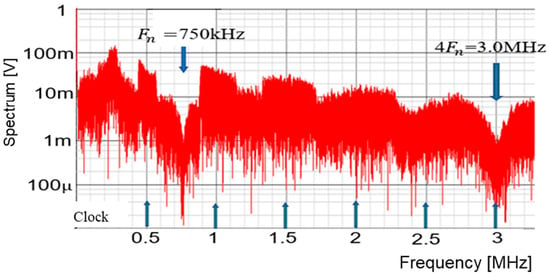
Figure 54.
Simulated spectrum with spread spectrum for .
Next, we discuss the case for P = 2. Figure 55 displays the simulated waveforms of pulse-H and pulse-L for = 1250 kHz, and we observe and . The expected is 1250 kHz based on Equation (24). The spectrum of the PWM signal is displayed in Figure 56. The notch is observed at 1270 kHz, which is equal to and falls between 2 and 3.
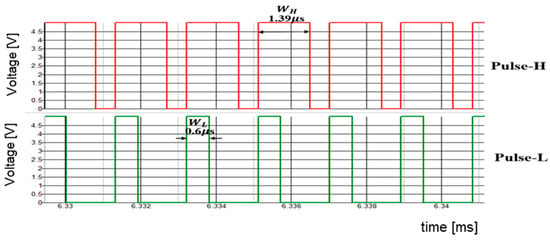
Figure 55.
Simulated waveforms for .
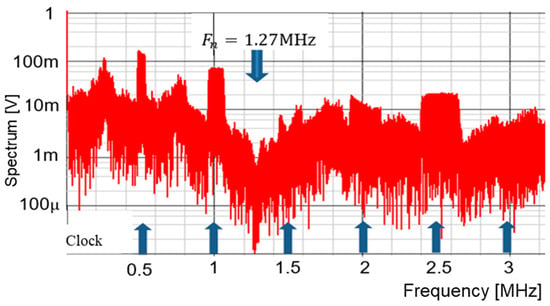
Figure 56.
Simulated spectrum with spread spectrum for .
Then, we consider the case for P = 3. Figure 57 displays the simulated waveforms of pulse-H and pulse-L for = 1750 kHz. Also, and . Based on Equation (24), is 1750 kHz. The spectrum of the PWM signal is displayed in Figure 58. The notch is observed at 1750 kHz, which corresponds to and lies between 3 and 4 .
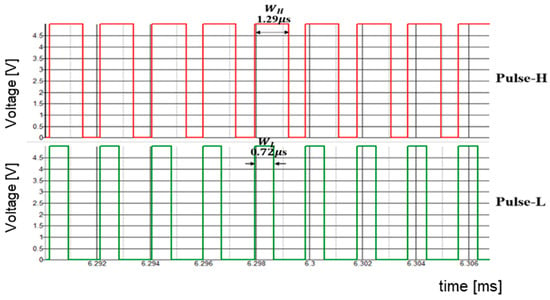
Figure 57.
Simulated waveforms for .
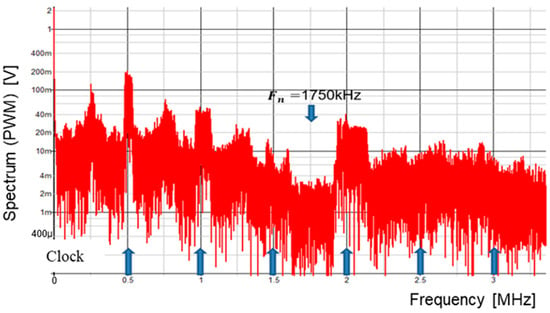
Figure 58.
Simulated spectrum with spread spectrum for .
(D) Automatic Setting of Notch Frequency from Input Frequency
Here, we discuss the automatic adjustment of changes from channel 1 to channel 2 in the radio receiver (Figure 59). We set D = 0.5, P = 1, and the of channel 1 to 750 kHz. Then, the output of the automatic PWC controller produces a notch at 750 kHz. In the case that changes to 1250 kHz, the corresponding , , and also change, and the notch is automatically produced at 1250 kHz. Simulated spectra are shown in Figure 60 and Figure 61, as changes from = 750 kHz to = 1250 kHz. The notches are observed at 750 kHz and 1250 kHz, which correspond to .

Figure 59.
Block diagram of change from channel 1 to channel 2.
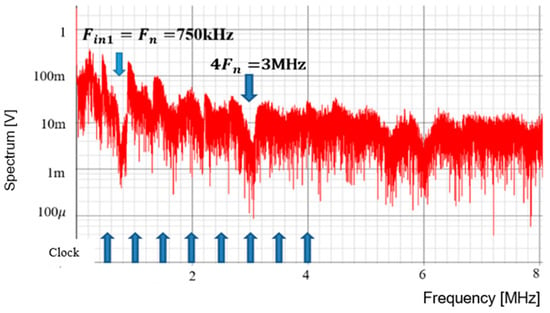
Figure 60.
Simulated spectrum for.
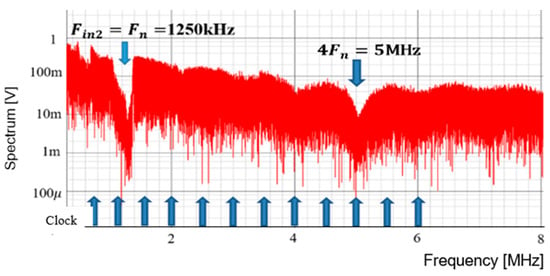
Figure 61.
Simulated spectrum for .
6.2. Automatic Notch Generation with PWPC Control
This subsection describes the automatic generation of pulse-H, pulse-L, and pulse-LD for the PWPC control.
(A) Automatic Generation Method of PWPC Control
In the PWPC method, is given by Equations (24) and (27), and Figure 62 illustrates the PWPC configuration. There, the automatic PWC controller generates NH and NL. Comparison of NH with the sawtooth waveform produces pulse-H, while comparison of NL with the delayed sawtooth produces pulse-LD. Figure 63 shows their waveforms, where the phase shift τ is equal to 0.5 , and Equation (24) is equal to Equation (27) for the steep notch.
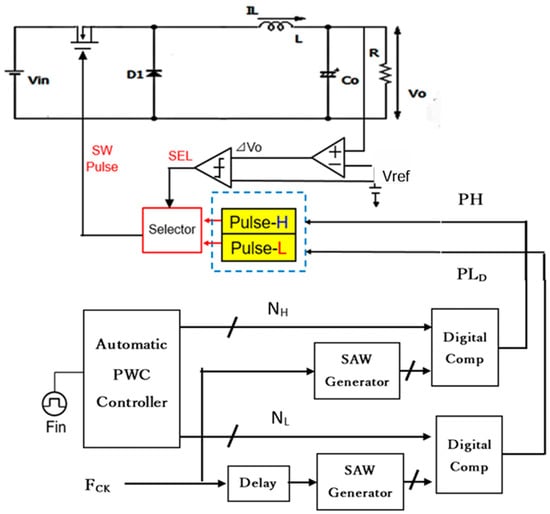
Figure 62.
Pulse coding circuit of the PWPC method.
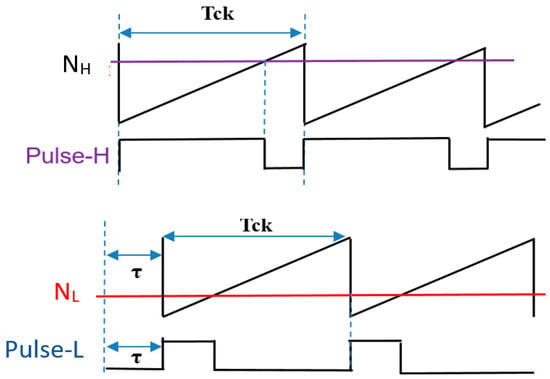
Figure 63.
Signals of PWPC control in Figure 62.
The relationship of and is given in Equation (44). For P = 1, the following is derived from Equation (47). Here, is the timing of the rear end of .
(B) Simulation Results of Automatic Notch Generation with PWPC Control
Figure 64 presents the sawtooth signals, and the primary signals are highlighted in Figure 65. The coding pulses , , and are generated by comparing and with the sawtooth and the delayed sawtooth signals.

Figure 64.
Sawtooth signals with period and delay τ. Green: Original sawtooth. Red: Delayed one.
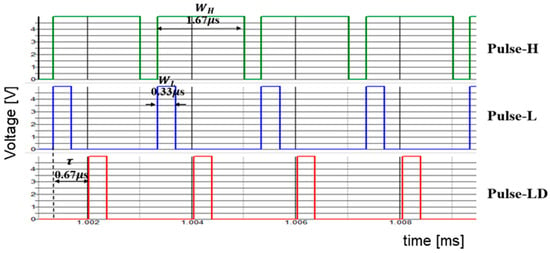
Figure 65.
Signals in PWPC circuit.
There, is 10 V, and is 5 V. When is set to 750 kHz and P = 1, is set to 500 kHz. To set to = 750 kHz, =1.67,, and = 0.67, based on Equation (51).
Simulation shows that with = 1.67, = 0.33, and = 0.67 is 750 kHz (=) (Figure 65 and Figure 66). A significant notch appears at 3.0 MHz (=4. Also, two notches are produced at higher frequencies.
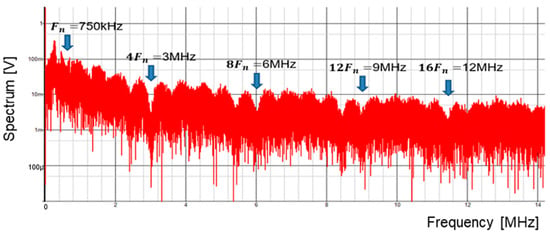
Figure 66.
Simulated spectrum with spread spectrum using PWPC method.
6.3. Duty Ratio Generation in Automatic Notch Generation
This subsection discusses a method to automatically detect and set D for and change.
(A) Analysis of Relationship Between Voltage Conversion Ratio and PWM Duty Ratio
In the automatic PWC control, alone can generate as well as and using Equations (52) and (53) based on Equations (45), (47), and (48). Also see Figure 51. When (shift value of D), Tin is set to (2/3)Tck for P = 1 based on Equation (45).
When varies, the duty cycle of SEL, is affected, which influences , and the resulting duty ratio is represented by Equation (54). During the circuit design, the Vo/Vi ratio is fixed, meaning , , and are set. Even if is changed, and are still produced automatically by the circuit. However, when Vo is changed, also is changed, which differs from the designed .
For instance, for and , we set D = Vo/Vi = 5 V/10 V = 0.5. That is, for and based on Equations (52) and (53), and = 0.5, the waveform of and remains balanced. However, when varies, changes to 0.86, and changes to 0.20. In the designed circuit, when remains at 0.5, is increased while is decreased.
In Equation (54), ∆D represents the variation of D, and the change rate is defined as x = ΔD/D. Then, the changed and , along with and , are given by Equations (55) to (58).
Before D varies, = 0.5 and . This means that the select signal keeps and balanced. After D varies, can be given by Equation (59). The average voltage of the SEL signal, , is given by Equation (60), and is influenced by . Consequently, when changes, increases.
It is inferred that when the duty ratio shifts from D to D’, changes to while changes to . Consequently, the select signal for and is no longer balanced. It influences VSEL, shifting it from Vcc/2 to Vcc (1 − ΔD/D)/2. Consequently, the output voltage also increases.
(B) Simulation Results of Duty Ratio Change
According to Section 5.2, when is varied while keeping and fixed, the duty cycle of SEL changes significantly. This causes significant variations in and . In simulation, 5.0 V and are altered to 10 V and 15 V. Correspondingly, D changes to 0.5 and 0.33. Figure 67 displays the select signal waveforms. It is observed that for = 0.5, the waveforms of and remain balanced. For D = 0.33, the waveform of the select signal becomes unbalanced, and the output of exceeds that of Figure 68 illustrates as varies. Any change in D affects .
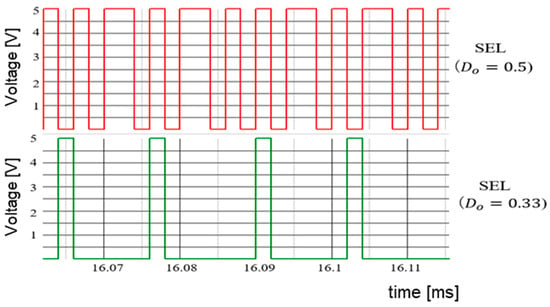
Figure 67.
Waveforms of SEL [] @IEICE.
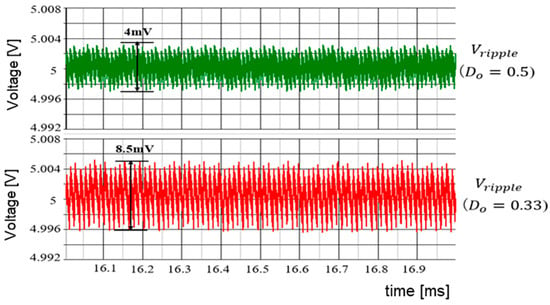
Figure 68.
Output voltage ripples [] @IEEE.
(C) Automatic Detection of PWM Duty
Based on D and Equations (52) and (53), and are generated (Figure 50). When varies, D also varies according to the ratio D = Vo/Vi. The number of and pulses are automatically adjusted based on D. The detection method of the SAW peak voltage produced by and Vi is considered. Under this condition, the peak voltage is proportional to D.
Figure 69 illustrates the automatic D detection circuit. There, the SAW signal is generated by a current source, with the frequency of the SAW designated as . A voltage follower serves as the peak hold circuit, and the peak voltage is compared with by an error amplifier, and an error voltage is generated. Usage of a voltage-controlled current source converts the error voltage into an error current, which is then fed back to the SAW generator. In this process, the SAW peak voltage is automatically detected, which is equal to . Then, the comparator produces the D detection signal by comparing the SAW signal with , which is equal to .

Figure 69.
Automatic D detection circuit [] @IEEE.
Figure 70 shows signal waveforms of the D detection circuit. For , the SAW peak voltage is 12 V. By comparing the SAW with , the sampled data correspond to . For = 10 V, the SAW peak voltage automatically changes to 10 V. By comparing the SAW and , the sampled data become .
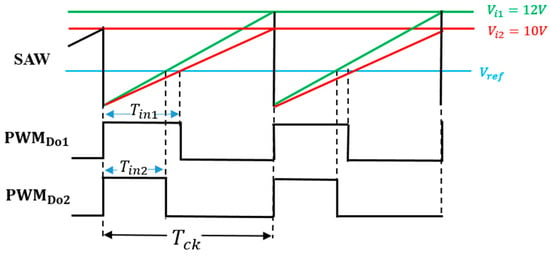
Figure 70.
Signals of detection circuit [] @IEEE.
We have developed an automatic notch frequency generator using this method. There, is automatically detected in response to a change for the notch creation at the input frequency. The simulation results are shown in Figure 71, with the same parameters as those in Section 5.1, except for , which is 15 V this time. Additionally, the clock is not modulated, and D can be automatically detected as 0.33. The simulation results show that the notch is at 750 kHz (=).
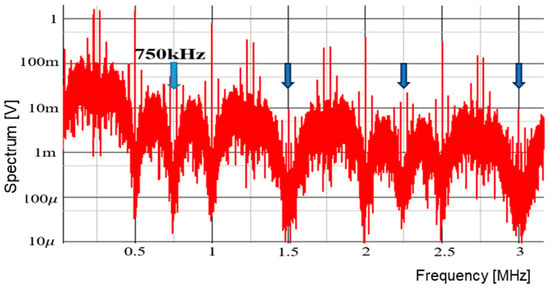
Figure 71.
Simulated spectrum with automatic generation without spread spectrum.
The SEL signal is illustrated in Figure 72. In comparison to Figure 67, under the condition of D = 0.33, the waveform of and remains balanced. The output voltage ripple is displayed in Figure 73, which is decreased from 8.5 mV to 1.1 mV, compared with Figure 68.
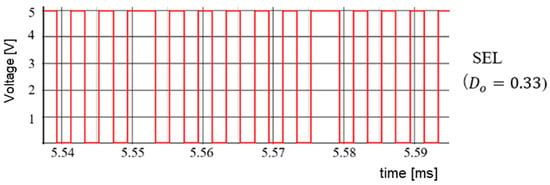
Figure 72.
SEL for automatic notch generation.
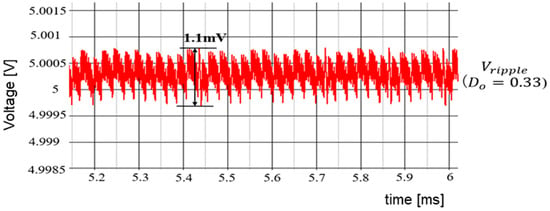
Figure 73.
Output voltage ripple in automatic notch generation.
The above discussion says that for setting D (0.33 < D < 0.67) in automatic notch generation with the PWC control and the D automatic detection method, D is detected based on the change in . This results in a notch being produced at , while reducing .
7. Implementation of PWC Controlled Converter with Notch Generation
7.1. Experiment of Converter with Notch Generation
We have verified the notch frequency using the PWC control with the prototype circuit in Figure 74, with the parameters in Table 4. Figure 75 shows its implemented prototype on a PCB board.
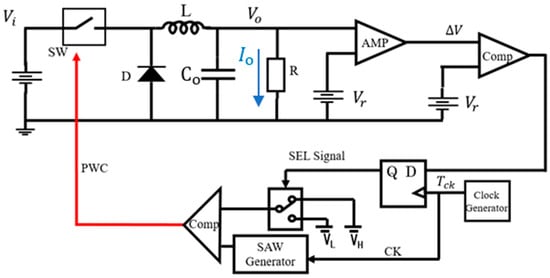
Figure 74.
Buck converter with PWC control.

Table 4.
Parameter values of Figure 72.
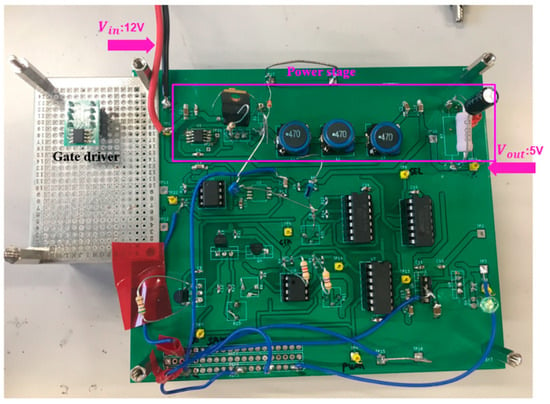
Figure 75.
Prototype of PWC control buck converter.
Figure 76 shows measured waveforms of and . Additionally, we have analyzed the spectrum of the PWC control converter with and (Figure 77). The notches appear between and 2 , between 2 and 3 , and between 3 and 4 . By substituting the parameter values into Equation (24), 1.66 MHz is obtained, which agrees with the measured result.
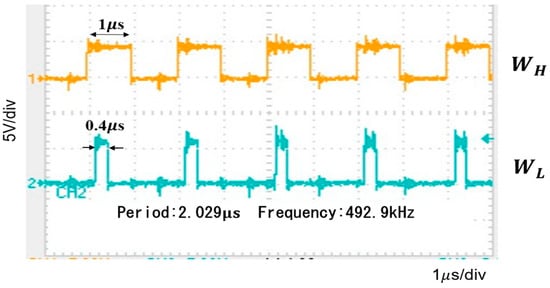
Figure 76.
Measured waveforms of and in the PWC control converter.

Figure 77.
Measured spectrum of the PWC control converter.
7.2. Experiment of Automatic Notch Generation
Experiments examine the notch characteristics using the prototype circuit.
(A) Experiment Method of Automatic Notch Generation
In the automatic notch generation method, the control stage circuit corresponds to the one in Figure 50. We expect that by inputting , the notch is automatically produced at . We have . In the 1.5 frequency generation circuit (pink border), inputting a pulse with a period of produces . The waveforms of , , , and are illustrated in Figure 78. By comparing the sawtooth waveform with to and , and are generated, respectively.
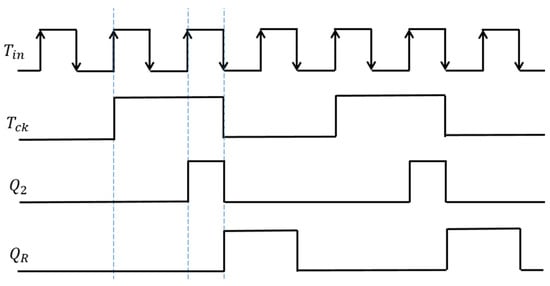
Figure 78.
Signals when produces .
Figure 79 shows the prototype with three red wires connecting the two boards. By inputting a pulse with a period of using a pulse generator, a notch is produced automatically at the same frequency. Next, we evaluate the prototype circuit with the parameters in Table 5.

Figure 79.
Prototype for automatic notch generation.

Table 5.
Parameters of prototype.
For the first example, we set P = 1 in Equation (44), and a notch is produced between and 2 . We input = 400 kHz, and can be automatically about 267 kHz (), and (Figure 80a). The PWM and SEL signals are shown in Figure 80b. Based on Equation (24), the notch frequency is calculated as 435 kHz. From the experimental spectrum, the observed notch frequency is approximately 400 kHz, which closely matches the theoretical result by Equation (24) and lies between and 2 .
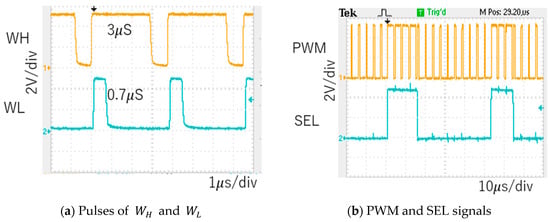
Figure 80.
Measured waveforms ().
(B) Experimental Results of Automatic Notch Generation
When is 400 kHz, is automatically set to 267 kHz ( = 3.7 μs) for P = 1. The pulse widths are automatically adjusted to = 3.0 μs and = 0.7 μs (Figure 80a). The PWM and SEL signals are illustrated in Figure 80b. can be calculated as 435 kHz based on Equation (30). The experiments show that the observed is around 425 kHz (Figure 81), which matches the theoretical result in Equation (30), and that this notch lies between and .
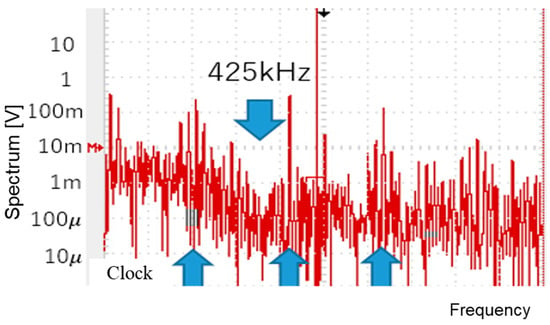
Figure 81.
Measured spectrum of PWM signal ().
For the second example, P = 1 is used. By changing to 600 kHz, can be automatically adjusted to 400 kHz (). Consequently, and (Figure 82a). The PWM and SEL signals are illustrated in Figure 82b. is calculated as 666 kHz based on Equation (24), and the experimental results show that the observed notch is at 666 kHz (Figure 83), which lies between and .
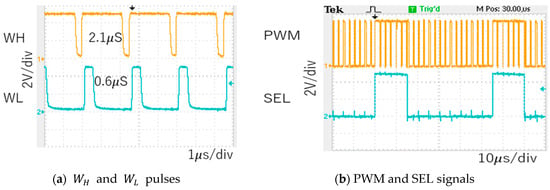
Figure 82.
Measured waveforms ().

Figure 83.
Measured spectrum of PWM signal ().
8. Discussion on Applications to Sensor Systems
This section discusses possible applications of the reviewed band-selective noise spread spectrum technologies to sensor systems. This paper addresses the noise issues in DC–DC converters, which are a critical concern for every sensor system designer. In particular, it focuses on the signal band noise problems affecting the receiver [,,]. The receiver can be considered a type of sensor system.
The reviewed technology is a switching power supply with notch characteristics, which does not generate noise (spectrum) near the reception frequency for weak radio wave receivers. Specifically, it minimizes noise spectra at specific frequencies in conducted and radiated noise.
In high-performance, compact, lightweight, and low-cost transmission and reception devices, such as cellular transceivers [,,] or wildlife tracking equipment [,,], it is possible to eliminate the need for power noise prevention components like power noise covers or filter circuits. This contributes significantly to the miniaturization, lightweight design, and cost efficiency of these devices.
Providing a switching power supply for receiver systems is frequently used in amateur radio or aviation-related wireless communications [], where the switching of reception frequencies (channel switching) occurs frequently. This power supply automatically adjusts the notch frequency of the noise spectrum in response to changes in the reception’s primary frequency
Portable sensor systems capable of receiving and detecting weak radio waves hold great potential for applications of the reviewed technology. Here are some representative examples [,,,,,,,,]:
- Wireless communication monitoring: small sensors are used to detect weak signals from technologies such as Wi-Fi, Bluetooth, and NFC. This allows for monitoring the health of communication environments and identifying abnormalities;
- Radio wave leakage detection: this system can be utilized in highly confidential environments to detect radio waves leaking externally and prevent information breaches;
- Frequency identification: detecting weak radio signals and pinpointing their sources or frequency bands can assist in investigations aimed at reducing radio interference;
- Smart home appliance management: an application that detects weak radio waves emitted by smart devices within the household using sensors, allowing for the management of device operational status and connection status;
- Security and surveillance system: detect suspicious signals to monitor unauthorized use of drones or communication devices, enhancing overall security;
- Healthcare: detecting environmental electromagnetic waves (e.g., EMF: Electromagnetic Field) that may affect the human body to aid in environmental management and health protection;
- Scientific investigation: detecting extremely weak signals in the environment has the potential to lead to new discoveries in fields such as space exploration, geology, and meteorology;
- IoT (Internet of Things): sensors detect the faint signals generated by IoT devices, enabling the optimization of networks and efficient energy management.
The advantages of portable sensor systems lie in their ease of transportation and flexible installation. Since each application requires specific technologies and requirements, it is essential to design them tailored to the target use.
9. Conclusions
This paper reviews technologies to realize the selectable band in the EMI noise spread spectrum of the DC–DC switching converter; their fundamental circuit, principles, theoretical analysis, simulation, and measurement results are presented. The EMI noise is diffused from the switching signals caused by the clock, and then, the noise spread spectrum techniques with the selectable notch band at the undesirable frequency such as the receiving radio signal band have been developed, while conventional methods may allow noise to encroach upon the signal band.
We review the Pulse Coding Driving (PCD) control method in the selectable notch frequency noise spread spectrum technology. It controls the output voltage using two different pulse counts such as the pulse width coding (PWC) method, pulse phase coding (PPC) method, and a combination of pulse width and phase coding methods. The PCD control can be used in conjunction with the PWM control.
Also, the theoretical derivation of their notch frequencies is shown. The derived equations represent the Fourier transform of the pulse-coded signals, rather than those of the entire converter system. However, the notch frequencies obtained from both the simulation and experimental results align closely with the derived theoretical equations. The derivation of equations for the complete converter will be addressed in future work. Furthermore, the comparison of noise spectrum shapes between simulation and measurement results should be performed with precision, although it may be influenced by various practical circuit parameters, such as the clock slew rate and parasitic effects. Additionally, as future work, a quantitative comparison with conventional methods concerning the noise spread spectrum effect should be conducted.
Further, a PCD control method that automatically tracks changes in the receiving frequency and the input voltage is introduced. The receiving frequency is often switched in the radio receiver, and the input frequency fluctuates. There, the notch band characteristics need to automatically switch to another reception band. We explain a method to detect the received frequency and automatically switch the clock frequency to the proper one, as well as a method so that, for the input voltage change, the PCD control automatically sets two types of pulse counts, while the conventional method automatically controls the duty of the PWM signal.
Finally, we review a PWC control method for automatic notch generation, with the notch characteristics of two types of PCD pulses and their spectra. There, the PCD pulses and the switching of notch frequencies are changed when the reception frequency is switched.
The expansion to the FM and higher frequency bands for the notch and the application to various converters such as single-inductor multi-output converters [,,,] as well as its implementation in sensor systems are anticipated to be future challenges. Also, IC implementation of the reviewed methods is a next work.
Author Contributions
Writing—original draft preparation, Y.K. and Y.S.; writing—review and editing, H.K.; project administration, H.K. All authors have read and agreed to the published version of the manuscript.
Funding
This research received no external funding.
Acknowledgments
All of the authors’ lab members and research collaborators who contributed to the research described in this paper are acknowledged.
Conflicts of Interest
The authors declare no conflict of interest.
References
- Harada, K.; Ninomiya, T.; Gu, B. Circuit Scheme of PWM Converter in Basics of Switching Converter; Corona Publishing: Tokyo, Japan, 1992. [Google Scholar]
- Stratakos, A.J.; Sullivan, C.R.; Sandersand, S.R.; Broderson, R.W. High-Efficiency Low-Voltage DC-DC Conversion for Portable Applications in Low-Voltage/Low-Power Integrated Circuits and Systems; IEEE Press: New York City, NY, USA, 1999; Chapter 12. [Google Scholar]
- Trzynadlowski, A.M.; Wang, Z.; Nagashima, J.M.; Stancu, C.; Zelechowsk, M.H. Comparative Investigation of PWM Techniques for a New Drive for Electric Vehicles. IEEE Trans. Ind. Appl. 2003, 39, 1396–1403. [Google Scholar] [CrossRef]
- Erickson, R.W.; Maksimović, D. Fundamentals of Power Electronics, 3rd ed.; Springer: Berlin/Heidelberg, Germany, 2020. [Google Scholar]
- Taniguchi, K.; Sato, T.; Nabeshima, T.; Nishijima, K. Constant Frequency Hysteretic PWM Controlled Buck Converter. In Proceedings of the International Conference on Power Electronics and Drive Systems (PEDS), Taipei, Taiwan, 2–5 November 2009; pp. 1194–1199. [Google Scholar]
- Lai, R.; Maillet, Y.; Wang, F.; Wang, S.; Burgos, R.; Boroyevich, D. An Integrated EMI Choke for Differential-mode and Common-mode Noise Suppression. IEEE Trans. Power Electron. 2010, 25, 539–544. [Google Scholar]
- Stankovic, A.M.; Verghese, G.C.; Perreault, D.J. Analysis and Synthesis of Randomized Modulation Schemes for Power Converters. IEEE Trans. Power Electron. 1995, 10, 680–693. [Google Scholar] [CrossRef]
- Tse, K.K.; Chung, H.S.; Hui, S.Y.; So, H.C. Analysis and Spectral Characteristics of a Spread-Spectrum Technique for Conducted EMI Suppression. IEEE Trans. Power Electron. 2000, 15, 399–410. [Google Scholar] [CrossRef]
- Giral, H.; Aroudi, E.A.; Martinez-Salamero, L.; Leyva, R.; Maixe, J. Current Control Technique for Improving EMC in Power Converters. Electron. Lett. 2001, 37, 274–275. [Google Scholar] [CrossRef]
- Yuan, B.; Liang, C.; Li, Z.; Zhang, Q. A Clock Generator with Dual Pseudo Random Spread Spectrum in DC-DC Buck Converter. In Proceedings of the IEEE International Conference on Integrated Circuits, Technologies and Applications (ICTA), Hangzhou, China, 25–27 October 2024; pp. 126–127. [Google Scholar]
- Mihali, F.; Kos, D. Reduced Conductive EMI in Switched-mode DC–DC Power Converters without EMI Filters: PWM versus Randomized PWM. IEEE Trans. Power Electron. 2006, 21, 1783–1794. [Google Scholar] [CrossRef]
- Li, H.; Tang, W.K.S.; Li, Z.; Halang, W.A. A Chaotic Peak Current Mode Boost Converter for EMI Reduction and Ripple Suppression. IEEE Trans. Circuits Syst. II Express Briefs 2008, 55, 763–767. [Google Scholar] [CrossRef]
- Kao, Y.-H.; Hung, C.-S.; Chang, H.-H.; Guo, B.; Tsai, Y. A 48V-to-5V Buck Converter with Triple EMI Suppression Circuit Meeting CISPR 25 Automotive Standards. In Proceedings of the IEEE International Solid-State Circuits Conference, San Francisco, CA, USA, 18–22 February 2024; pp. 164–166. [Google Scholar]
- Fishta, M.; Raviola, E.; Fiori, F. EMI Reduction at the Source in WBG Inverters: A Comparative Study of Spread-Spectrum Modulation and Auxiliary Switching Leg Techniques. IEEE Trans. Electromagn. Compat. 2024, 66, 1412–1419. [Google Scholar] [CrossRef]
- Stok, E.; Otten, M.; Huisman, H.; Kösesoy, Y. EMI Reduction in an Interleaved Buck Converter Through Spread Spectrum Frequency Modulation. In Proceedings of the 25th European Conference on Power Electronics and Applications (EPE’23 ECCE Europe), Aalborg, Denmark, 4–8 September 2023; pp. 1–11. [Google Scholar]
- Sun, T.-W.; Li, M.-Z.; Tsai, T.-H.; Chang, C.-C. A High-Accuracy Hysteretic DC-DC Converter Using a Spread-Spectrum EMI Suppression Technique with Double Gold Codes. In Proceedings of the 21st IEEE Interregional NEWCAS Conference (NEWCAS), Edinburgh, UK, 26–28 June 2023; pp. 1–4. [Google Scholar]
- Barbaro, A.; Fishta, M.; Raviola, E.; Fiori, F. A Comparison of Spread Spectrum and Sigma Delta Modulations to Mitigate Conducted EMI in GaN-Based DC-DC Converters. In Proceedings of the 14th International Workshop on the Electromagnetic Compatibility of Integrated Circuits (EMC Compo), Torino, Italy, 7–9 October 2024; pp. 1–6. [Google Scholar]
- Kundrata, J.; Baric, A. Clock Frequency Optimization of a Compensated Spread-Spectrum Controller in Buck Converters. IEEE Access 2024, 12, 4881–4891. [Google Scholar] [CrossRef]
- Kapat, S. Reconfigurable Periodic Bi-frequency DPWM with Custom Harmonic Reduction in DC-DC Converters. IEEE Trans. Power Electron. 2016, 31, 3380–3388. [Google Scholar] [CrossRef]
- Kundrata, J.; Barić, A. Implementation of Voltage Regulation in a Spread-Spectrum-Clocked Buck Converter. In Proceedings of the 46th MIPRO ICT and Electronics Convention (MIPRO), Opatija, Croatia, 22–26 May 2023; pp. 253–258. [Google Scholar]
- Ioinovici, A. Switched-Capacitor Power Electronics Circuits. IEEE Circuits Syst. Mag. 2001, 1, 37–42. [Google Scholar] [CrossRef]
- Li, P.; Bazzi, A.; Zhang, Z. High-Performance Control of Battery-Interfacing Cascade Buck-Boost Converter. In Proceedings of the IEEE Transportation Electrification Conference and Expo, Chicago, IL, USA, 19–21 June 2024; pp. 1–6. [Google Scholar]
- Tanaka, T.; Ninomiya, T.; Harada, K. Random-Switching Control in DC-DC Converters. In Proceedings of the IEEE PESC, Milwaukee, WI, USA, 26–29 June 1989; pp. 500–507. [Google Scholar]
- Tanaka, T.; Ninomiya, T. Random-Switching Control for DC-DC Converters: Analysis of Noise Spectrum. In Proceedings of the IEEE 23rd Power Electronics Specialists Conference, Toledo, Spain, 29 June–3 July 1992. [Google Scholar]
- Tanaka, T.; Hamasaki, H.; Yoshida, H. Random-Switching Control in DC-to-DC Converters: An Implementation Using M-Sequence. In Proceedings of the Power and Energy Systems in Converging Markets, Melbourne, VIC, Australia, 23 October 1997; pp. 431–437. [Google Scholar]
- Lin, Y.; Hsu, C.; Lin, Y.-D. A Low EMI DC-DC Buck Converter with a Triangular Spread-Spectrum Mechanism. Energies 2020, 13, 856. [Google Scholar] [CrossRef]
- Iraheta, A. Further Optimizing EMI with Spread Spectrum; Application Report; Texas Instruments: Dallas, TX, USA, 2021. [Google Scholar]
- Curtis, P.; Lee, E. EMI Reduction Technique, Dual Random Spread Spectrum; Application Note; Texas Instruments: Dallas, TX, USA, 2022. [Google Scholar]
- Pareschi, F.; Rovatti, R.; Setti, G. EMI Reduction via Spread Spectrum in DC/DC Converters: State of the Art, Optimization, and Tradeoffs. IEEE Access 2015, 3, 2857–2874. [Google Scholar] [CrossRef]
- Leonard, J. Dual Switcher with Spread Spectrum Reduces EMI. Linear Technol. Mag. 2004, 9–11. Available online: https://www.analog.com/en/resources/technical-articles/dual-switcher-spread-spectrum-reduces-emi.html (accessed on 26 April 2025).
- Zimmer, G.; Scott, K. Spread Spectrum Frequency Modulation Reduces EMI, Technical Article, Analog Devices. Available online: https://www.analog.com/en/resources/technical-articles/spread-spectrum-frequency-modulation-reduces-emi.html (accessed on 26 April 2025).
- Jaffe, S. The Pros and Cons of Spread-Spectrum Implementation Methods in Buck Regulators. Analog. Des. J. 2021, 1–6. Available online: https://www.ti.com/lit/an/slyt809/slyt809.pdf?ts=1714816631894 (accessed on 26 April 2025).
- Miki, N.; Tsukiji, N.; Asaishi, K.; Kobori, Y.; Takai, N.; Kobayashi, H. EMI Reduction Technique With Noise Spread Spectrum Using Swept Frequency Modulation for Hysteretic DC-DC Converters. In Proceedings of the IEEE International Symposium on Intelligent Signal Processing and Communication Systems (ISPACS), Xiamen, China, 6–9 November 2017. [Google Scholar]
- Oiwa, N.; Sakurai, S.; Sun, Y.; Tri, M.T.; Li, J.; Kobori, Y.; Kobayashi, H. EMI Noise Reduction for PFC Converter with Improved Efficiency and High Frequency Clock. In Proceedings of the IEEE 14th International Conference on Solid-State and Integrated Circuit Technology, Qingdao, China, 31 October–3 November 2018. [Google Scholar]
- Kobori, Y.; Sun, Y.; Tri, M.T.; Kuwana, A.; Kobayashi, H. EMI Reduction in Switching Converters With Pseudo Random Analog Noise. J. Technol. Soc. Sci. 2020, 4, 33–48. [Google Scholar]
- Kobori, Y.; Arafune, T.; Tsukiji, N.; Kobayashi, H. Selectable Notch Frequencies of EMI Spread Spectrum Using Pulse Modulation in Switching Converter. In Proceedings of the IEEE 11th International Conference on ASIC, Chengdu, China, 3–6 November 2015. [Google Scholar]
- Sun, Y.; Kobori, Y.; Kobayashi, H. Full Automatic Notch Generation in Noise Spectrum of Pulse Coding Controlled Switching Converter. In Proceedings of the IEEE 14th International Conference on Solid-State and Integrated Circuit Technology, Qingdao, China, 31 October–3 November 2018. [Google Scholar]
- Sun, Y.; Kobori, Y.; Kuwana, A.; Kobayashi, H. Pulse Coding Controlled Switching Converter that Generates Notch Frequency to Suit Noise Spectrum. IEICE Trans. Commun. 2020, E103-B, 1331–1340. [Google Scholar] [CrossRef]
- Dong, G.; Katayama, S.; Sun, Y.; Kobori, Y.; Kuwana, A.; Kobayashi, H. Notch Frequency Generation Methods in Noise Spread Spectrum for Pulse Coding Switching DC-DC Converter. In Proceedings of the 13th Latin American Symposium on Circuits and Systems, Santiago, Chile, 1–4 March 2022. [Google Scholar]
- Gamoudi, R.; Chariag, D.E.; Sbita, L. A Review of Spread-Spectrum-Based PWM Techniques—A Novel Fast Digital Implementation. IEEE Trans. Power Electron. 2018, 33, 10292–10307. [Google Scholar] [CrossRef]
- Jankovskis, J.; Stepins, D.; Tjukovs, S.; Pikulins, D. Examination of Different Spread Spectrum Techniques for EMI Suppression in dc/dc Converters. Elektron. Ir Elektrotechnika 2008, 86, 60–64. [Google Scholar]
- Dousoky, G.M.; Shoyama, M.; Ninomiya, T. FPGA-Based Spread-Spectrum Schemes for Conducted-Noise Mitigation in DC–DC Power Converters: Design, Implementation, and Experimental Investigation. IEEE Trans. Ind. Electron. 2011, 58, 429–435. [Google Scholar] [CrossRef]
- Hegarty, T. An Overview of Radiated EMI Specifications for Power Supplies; White Paper; Texas Instruments: Dallas, TX, USA, 2018. [Google Scholar]
- Hegarty, T. An Overview of Conducted EMI Specifications for Power Supplies; White Paper; Texas Instruments: Dallas, TX, USA, 2018. [Google Scholar]
- Hegarty, T. A Review of EMI Standards, Part 2—Radiated Emissions; White Paper; Texas Instruments: Dallas, TX, USA, 2018. [Google Scholar]
- Pozar, D.M. Microwave Engineering, 4th ed.; Wiley: Hoboken, NJ, USA, 2011. [Google Scholar]
- Razavi, B. RF Microelectronics, 2nd ed.; Prentice Hall: Englewood Cliffs, NJ, USA, 2011. [Google Scholar]
- Rappaport, T.S. Wireless Communications: Principles and Practice, 2nd ed.; Cambridge University Press: Cambridge, UK, 2024. [Google Scholar]
- Pereira, E.; Araújo, Í.; Silva, L.F.V.; Batista, M.; Júnior, S.; Barboza, E. RFID Technology for Animal Tracking: A Survey. IEEE J. Radio Freq. Identif. 2023, 7, 609–620. [Google Scholar] [CrossRef]
- Priyadharsini, S.; Renukasri, V.; Sneha, R.; Sowmiya, P.K.; Swaathi, K. Wildlife Animal Tracking System using GPS and GSM. Int. J. Eng. Res. Technol. 2020, 8, 6–8. [Google Scholar]
- Kim, S.-H.; Kim, D.-H.; Park, H.-D. Animal Situation Tracking Service Using RFID, GPS, and Sensors. In Proceedings of the IEEE Second International Conference on Computer and Network Technology, Bangkok, Thailand, 23–25 April 2010; pp. 153–156. [Google Scholar]
- Park, P.; Di Marco, P.; Nah, J.; Fischione, C. Wireless Avionics Intracommunications: A Survey of Benefits, Challenges, and Solutions. IEEE Internet Things J. 2021, 8, 7745–7767. [Google Scholar] [CrossRef]
- Sazonov, E. (Ed.) Wearable Sensors: Fundamentals, Implementation and Applications, 2nd ed.; Academic Press: Cambridge, MA, USA, 2020. [Google Scholar]
- Wilson, J.S. (Ed.) Sensor Technology Handbook; Elsevier: Amsterdam, The Netherlands, 2005. [Google Scholar]
- Roggen, D. Mobile Sensors and Context-Aware Computing; Morgan Kaufmann Publishers Inc.: Burlington, MA, USA, 2015. [Google Scholar]
- Khanna, V.K. IoT Sensors—An Exploration of Sensors for Internet of Things; CRC Press: Boca Raton, FL, USA, 2024. [Google Scholar]
- Pradhan, B.; Mukhopadhyay, S.; Sensors, I. AI and XAI: Empowering a Smarter World; Springer: Berlin/Heidelberg, Germany, 2024. [Google Scholar]
- Vermesan, O.; Friess, P. (Eds.) Internet of Things Applications—From Research and Innovation to Market Deployment; River Publishers: Copenhagen, Denmark, 2022. [Google Scholar]
- Lee, A.T.L.; Jin, W.; Tan, S.-C.; Hui, R.S.Y. Single-Inductor Multiple-Output Converters: Topologies, Implementation, and Applications, 1st ed.; CRC Press: Boca Raton, FL, USA, 2021. [Google Scholar]
- Rooholahi, B.; Siwakoti, Y.P.; Eckel, H.-G.; Blaabjerg, F.; Bahman, A.S. Enhanced Single-Inductor Single-Input Dual-Output DC–DC Converter With Voltage Balancing Capability. IEEE Trans. Ind. Electron. 2024, 71, 7241–7251. [Google Scholar] [CrossRef]
- Zhang, X.; Zhao, A.; Li, X.; Jiang, Y.; Martins, R.P.; Mak, P.-I. An 80W Single-Inductor DC-DC Architecture for Simultaneous Flash Charging and Dual-Output PoL Supply with 92.1% Peak Efficiency from 15V-to-28V Input to 12.6V/3.3V/1V Outputs Using 1.3 mm3 Inductor. In Proceedings of the IEEE European Solid-State Electronics Research Conference (ESSERC), Bruges, Belgium, 9–12 September 2024; pp. 61–64. [Google Scholar]
- Yeh, W.-T.; Cai, M.-X.; Tsai, C.-W.; Tsai, C.-H. A Single-Inductor Bipolar-Output DC-DC Converter With Tunable Asymmetric Power Distribution Control (APDC) for AMOLED Applications. IEEE Access 2025, 13, 6810–6819. [Google Scholar] [CrossRef]
Disclaimer/Publisher’s Note: The statements, opinions and data contained in all publications are solely those of the individual author(s) and contributor(s) and not of MDPI and/or the editor(s). MDPI and/or the editor(s) disclaim responsibility for any injury to people or property resulting from any ideas, methods, instructions or products referred to in the content. |
© 2025 by the authors. Licensee MDPI, Basel, Switzerland. This article is an open access article distributed under the terms and conditions of the Creative Commons Attribution (CC BY) license (https://creativecommons.org/licenses/by/4.0/).